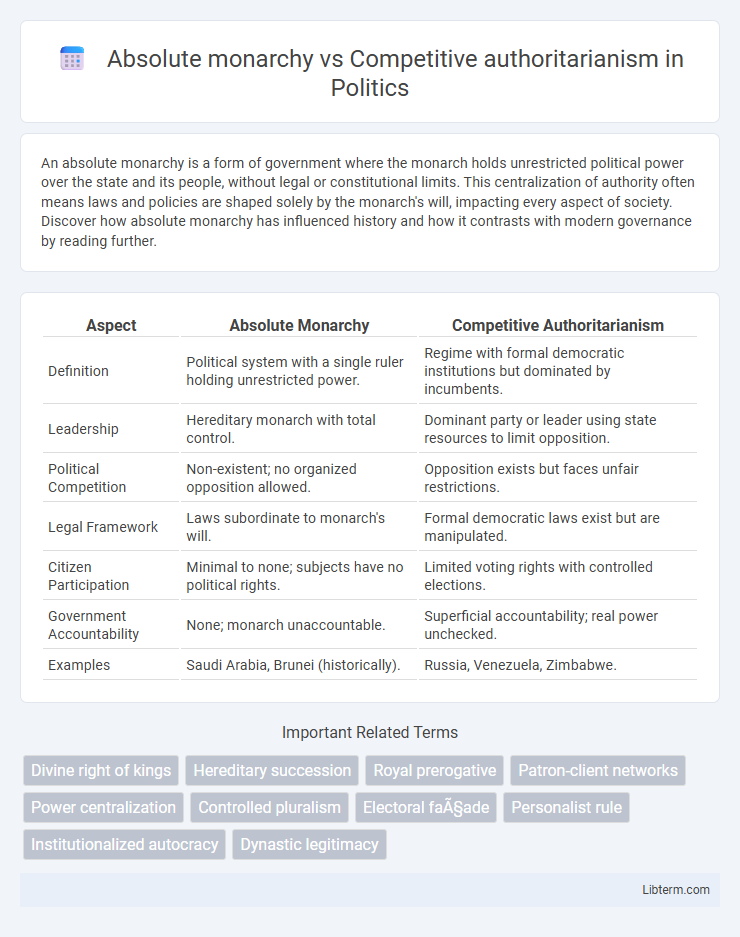An absolute monarchy is a form of government where the monarch holds unrestricted political power over the state and its people, without legal or constitutional limits. This centralization of authority often means laws and policies are shaped solely by the monarch's will, impacting every aspect of society. Discover how absolute monarchy has influenced history and how it contrasts with modern governance by reading further.
Table of Comparison
| Aspect | Absolute Monarchy | Competitive Authoritarianism |
|---|---|---|
| Definition | Political system with a single ruler holding unrestricted power. | Regime with formal democratic institutions but dominated by incumbents. |
| Leadership | Hereditary monarch with total control. | Dominant party or leader using state resources to limit opposition. |
| Political Competition | Non-existent; no organized opposition allowed. | Opposition exists but faces unfair restrictions. |
| Legal Framework | Laws subordinate to monarch's will. | Formal democratic laws exist but are manipulated. |
| Citizen Participation | Minimal to none; subjects have no political rights. | Limited voting rights with controlled elections. |
| Government Accountability | None; monarch unaccountable. | Superficial accountability; real power unchecked. |
| Examples | Saudi Arabia, Brunei (historically). | Russia, Venezuela, Zimbabwe. |
Understanding Absolute Monarchy: Definition and Key Features
Absolute monarchy is a form of government where the monarch holds supreme autocratic authority, centralized without constitutional limitations. Key features include hereditary succession, centralized control over the military and bureaucracy, and the absence of legal or institutional checks on the ruler's power. This system contrasts with competitive authoritarianism, where formal democratic institutions exist but are undermined by incumbents to maintain dominance.
Competitive Authoritarianism: Origins and Core Characteristics
Competitive authoritarianism originates from hybrid regimes where formal democratic institutions exist but are heavily skewed in favor of incumbents. Core characteristics include limited political pluralism, controlled media, electoral manipulation, and suppression of opposition through legal and extralegal means. These regimes maintain a facade of democracy while concentrating power, undermining genuine competition and accountability.
Historical Evolution of Absolute Monarchies
Absolute monarchies emerged predominantly in Europe between the 16th and 18th centuries, characterized by centralized power vested in a single sovereign often justified by the divine right of kings. These monarchies evolved through the decline of feudalism, the consolidation of state institutions, and the suppression of competing political entities such as parliaments or nobility. In contrast to competitive authoritarian regimes, which blend formal democratic institutions with autocratic practices, absolute monarchies lacked institutional checks and balances, maintaining unchallenged authority until the rise of modern nation-states and constitutionalism.
The Rise of Competitive Authoritarian Regimes
The rise of competitive authoritarian regimes marks a shift from traditional absolute monarchies, where power is centralized and uncontested, to hybrid systems blending democratic institutions with authoritarian practices. Competitive authoritarianism allows limited political competition through elections, but incumbents manipulate media, judiciary, and electoral processes to maintain dominance. This regime type adapts authoritarian control to modern political realities, enabling rulers to claim legitimacy while suppressing effective opposition.
Power Structure: Monarchs vs. Political Elites
Absolute monarchy centralizes power exclusively in the hands of monarchs who exercise unchecked authority over the state and its institutions. In competitive authoritarianism, power is held by a mix of political elites who maintain control through flawed democratic processes and limited political competition. Monarchs rule based on hereditary succession, while competitive authoritarian regimes rely on elite coalitions that manipulate electoral and political mechanisms to sustain dominance.
Legitimacy and Sources of Authority in Both Systems
Absolute monarchy derives legitimacy from hereditary succession and divine right, centralizing authority in a single ruler with unquestioned power, often legitimized through tradition and religious sanction. Competitive authoritarianism blends formal democratic institutions with authoritarian practices, where legitimacy stems from contested elections and nominally legal frameworks, but power is consolidated through manipulation and repression. The sources of authority in absolute monarchies rest on unchallenged sovereignty and lineage, whereas in competitive authoritarian regimes, authority is maintained via controlled political competition and state apparatus dominance.
Political Participation: Citizens’ Role and Limitations
In absolute monarchy, political participation is highly restricted, as power is centralized in the hands of a single ruler who makes decisions without public input or electoral competition. Citizens have minimal to no formal role in government, and political opposition is often suppressed to maintain the monarch's control. In competitive authoritarianism, while elections and some political pluralism exist, authorities manipulate institutions to limit genuine competition, resulting in constrained citizen participation and restricted civil liberties.
Mechanisms of Control: Repression vs. Pseudo-Democracy
Absolute monarchy maintains control through direct repression, employing centralized power to suppress dissent and limit political freedoms without legal constraints. Competitive authoritarianism blends authoritarian repression with superficial democratic institutions, allowing limited political competition while manipulating elections, controlling media, and restricting opposition. This hybrid regime uses pseudo-democratic mechanisms to legitimize rule while systematically undermining genuine democratic processes.
Modern Examples: Case Studies in Monarchy and Authoritarianism
Modern examples of absolute monarchy include Saudi Arabia, where the monarchy wields unchecked political power without meaningful opposition, and Brunei, which maintains strict royal authority over governance. Competitive authoritarian regimes, such as Russia under Vladimir Putin and Hungary under Viktor Orban, exhibit formal democratic institutions but are characterized by electoral manipulation, media control, and repression of opposition that undermine genuine competition. These case studies highlight the divergence between monarchies with centralized hereditary rule and hybrid regimes employing authoritarian tactics within nominally democratic frameworks.
Impacts on Stability, Governance, and Human Rights
Absolute monarchy centralizes power in a single ruler, often ensuring political stability through unchallenged authority but frequently compromising governance transparency and human rights protections. Competitive authoritarianism features elements of democracy like elections, yet incumbents manipulate institutions to maintain dominance, leading to unstable governance and inconsistent human rights enforcement. The balance between control and competition in these regimes determines the extent of political stability and respect for civil liberties.
Absolute monarchy Infographic

 libterm.com
libterm.com